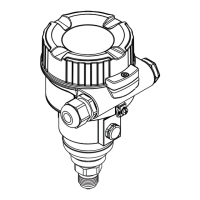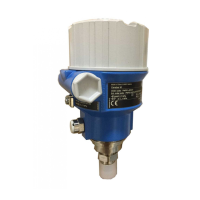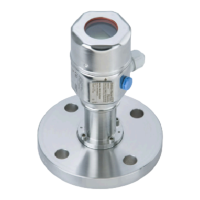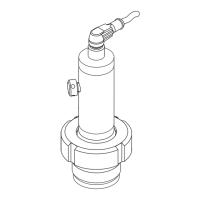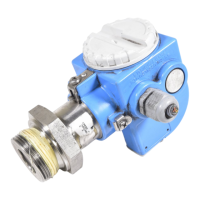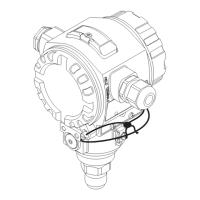Cerabar M PMC51, PMP51, PMP55
Endress+Hauser 115
Filling oil
Observe the temperatures and pressures during commissioning and cleaning. A further selection
criterion is the compatibility of the filling oil with the requirements of the medium. For example,
only filling oils that do not present a health hazard are used in the food industry, e.g. vegetable oil or
silicone oil. (See also the following section "Diaphragm seal filling oils".)
The filling oil used influences the thermal change, the temperature application range of a diaphragm
seal system and the response time. A temperature change results in a volume change in the filling
oil. The volume change depends on the thermal expansion coefficient of the filling oil and on the
volume of the fill fluid at calibration temperature (constant in the range:
+21 to +33 °C (+70 to +91 °F)).
For example, the filling oil expands in the event of a temperature increase. The additional volume
presses against the process isolating diaphragm of a diaphragm seal. The stiffer a process isolating
diaphragm is, the greater its return force, which counteracts a volume change and acts together with
the process pressure on the measuring cell, thus shifting the zero point.
Pressure transmitter
The pressure transmitter influences the temperature application range, the thermal change and the
response time as a result of its volume change. The volume change is the volume that has to be
shifted in order to pass through the complete measuring range.
Pressure transmitters from Endress+Hauser are optimized with regard to minimum volume change.
Diaphragm seal filling oils
Filling oil Permissible temperature range
1)
at
0.05 bar (0.725 psi) ≤ p
abs
≤ 1 bar (14.5 psi)
Permitted temperature range
1)
at
p
abs
≥1 bar (14.5 psi)
Option
2)
Silicone oil –40 to +180 °C (–40 to +356 °F) –40 to +250 °C (–40 to +482 °F) 1
Inert oil –40 to +80 °C (–40 to +176 °F) –40 to +175 °C (–40 to +347 °F) 2
Vegetable oil –10 to +120 °C (+14 to +248 °F) –10 to +200 °C (+14 to +392 °F) 4
Hightemperature oil –10 to +200 °C (+14 to +392 °F) –10 to +400 °C (+14 to +752 °F)
3) 4) 5)
5
Low temperature oil –70 to +80 °C (–94 to +176 °F) –70 to +180 °C (–94 to +356 °F) 6
1) Observe temperature limits of the device and of the system
2) Product Configurator, “Fill fluid” ordering feature
3) 325 °C (617 °F) at ≥1 bar (14.5 psi)absolute pressure.
4) 350 °C (662 °F) at ≥1 bar (14.5 psi) absolute pressure (max. 200 hours).
5) 400 °C (752 °F) at ≥1 bar (14.5 psi) absolute pressure (max. 10 hours).
Additional data:
Filling oil Density
[g/cm3] /
[SGU]
Viscosity
[mm²/s] / [cSt]
bei
25 °C (77 °F)
Expansion coefficient
1)
[1/K]
Notes
2)
Option
3)
Silicone oil 0.96 100 0.00096 suitable for foods FDA 21 CFR 175.105 1
Inert oil 1.87 27 0.000876 For ultrapure gas and oxygen applications 2
Vegetable oil 0.94 9.5 0.00101 suitable for foods FDA 21 CFR 172.856 4
Hightemperature oil 1.00 150 0.00096 High temperatures 5
Low temperature oil 0.92 4.4 0.00108 Low temperatures 6
1) The thermal change in the diaphragm seal and other important technical features can be found in the "Applicator Sizing Diaphragm Seal"
selection tool.
2) Only select FDA-approved filling oils for diaphragm seal devices with 3-A and EHEDG certification!
3) Product Configurator, “Fill fluid” ordering feature
Operating temperature range
The operating temperature range of a diaphragm seal system depends on the fill fluid, capillary
length and internal diameter, process temperature and oil volume of the diaphragm seal.

